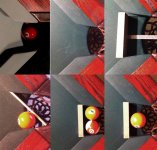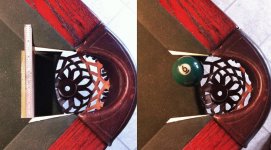This was mentioned in another thread, so I figured I'd just start a new one. Pocket cuts are like aiming systems as it seems people are very defensive about them, but I figured I'd explain my take on them, as I feel it's a very important element of what we're doing here at the WPBL arena.
I've been a firm believer that the current pocket cut in North America is one of the reason why pool is suffering here. Sounds a bit harsh, and maybe it is, but hopefully I can explain why. I've had an idea of how to improve this for a few years, and proposed it back in a thread last year.
http://forums.azbilliards.com/showthread.php?t=255620&highlight=pocket
Unfortunately I was met with nearly universal resistance, but I stuck with it anyway. Bonus Ball finally offered me the chance to put my ideas into action.
The issue is that the current pocket standard is penalizing the better players by opening the faces. It jaws balls, and forces players to play pocket speed, thus making the pocket play "phony". A player can slop a ball in softly if rolled in, but a well hit shot done firmly will be rejected. Its terrible for the better players, and even worse for TV, as players often opt to play safe instead of taking on a shot where a ball needs to be pounded in down the rail. I feel a player should be able to pound balls in with speed, with as much spin as possible, and the pocket should always accept it provided the shot was accurate. The aggressive guys who are willing to play dramatic shots should be rewarded, and this new cut does exactly that.
The trick is to shrink the pocket, push the facings back towards parallel so they're around 138 (rather than 141-142), and then ditch the shelf. A ball either goes in, or it misses entirely. No more pocket speed or jawed balls. If you put the ball into the tiny opening, it goes in. If you miss, it leaves the pocket area entirely, thus eliminating jawed balls almost entirely.
It's basically doing the exact opposite of what everyone else has been doing.
I called Ernesto, and had him cut the pockets the way I wanted. To my surprise, he agreed and said that he's done this before, and thinks its the way a pocket should be cut. Sure enough, as players trickled in during opening week, they all agreed. The result is what all the pros here are now calling "a true pro cut". As far as I know, the support is unanimous.
You have to be accurate as hell, but the balls take as they should. Its the best of all worlds, and I'm a firm believer that this will become the new standard, as I know that Rasson over in China is already testing this cut, and may make it the new standard in Asia (albeit 4.25" inch for amateurs, which plays like a 4.5"). Time will tell whether it takes, but from what I've seen this far, the pros may be hesitant to go back to the old cut style.
Please keep in mind that I'm just doing what I feel is best for the game. Not everyone will agree, but whats important to me is that its best for TV, and what the players now agree they want.

